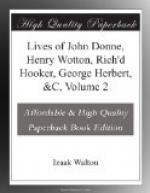[Footnote 8: John Hart, a Jesuit, was educated in the University of Oxford. In 1571 he was admitted to the English College at Douay, and in 1578 was ordained priest. Returning in 1580 to England, he was apprehended, tried, and condemned to death; but on the day of his execution he was reprieved, and sent back to the Tower, where he remained three years. It was during his confinement in the Tower that he held a disputation with Dr. Reynolds. In 1584, being banished from England, Hart proceeded to Verdun and joined the Society of Jesus. He died at Jarislau, in Poland, on 19 July, 1594.]
[Footnote 9: A man of great piety of life, and such gravity, that he was scarcely ever seen to laugh. He was a native of Westphalia, in Germany: was Canon of Christ Church, Vice-Chancellor of the University, and in 1585-86, was consecrated Bishop of Hereford.]
[Footnote 10: Sir H. Savile was born at Over Bradley, near Halifax in Yorkshire, Nov. 30th, 1549, and was entered of Merton College, Oxford. He was Greek and Mathematical Preceptor to Queen Elizabeth, and was one of the Translators of the Bible, under James I., who knighted him in 1604. He died Feb. 19th, 1621-22.]
[Footnote 11: Mr. Morrison, Secretary to Lord Mountjoy, and author of “An Itinerary, containing his ten Years Travels through the twelve Dominions of Germany, Bohmerland, Switzerland, Denmark, Poland, England, Scotland, and Ireland; divided into three Parts. London, 1617.” Fol. Published after his death, and originally written in Latin.]
[Footnote 12: The later editions of the Life of Hooker omit the account of this expulsion.]
[Footnote 13: A pulpit cross formed of timber, covered with lead, and mounted upon stone steps, which stood in the midst of the Church-yard of the Cathedral; in which Sermons were preached by eminent Divines every Sunday in the forenoon, when the Court, the Magistrates of the City, and a vast concourse of people usually attended. There is notice of its use so early as 1259, but it was not finished in its final form until 1449, by Kemp, Bishop of London, and it was finally destroyed by order of Parliament, in 1643. The Corporation of London ordained that all Ministers who came from a distance to preach at this Cross, were to have lodgings and provision for five days; and the Bishop of London gave them notice of their place of residence.]
[Footnote 14: The excellent Aylmer, was born at Aylmer-Hall, in Norfolk, in 1521, and was Tutor to Lady Jane Grey; he left England, during the reign of Mary, and went to Zurich. He returned on Elizabeth’s accession, and was made Bishop of London in March, 1576—7, strictly governing the Puritans throughout his Prelacy. He died in 1594.]
[Footnote 15: Two wretched fanatics; the first died in prison, and the second was hanged in 1591. Hacket was called by his followers “the supreme Monarch of the world from whom all Princes of Europe hold their sceptres,” and was held “to be a greater prophet than Moses or John Baptist, even Jesus Christ, who was come with his fan in his hand to judge the world.” Fuller says that Hacket was of so “cruel and fierce a nature that he is reported to have bit off and eat down the nose of his schoolmaster.”]




